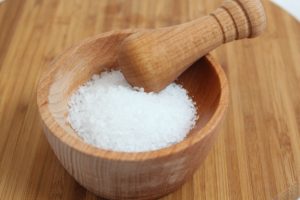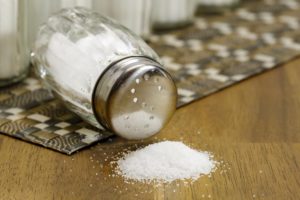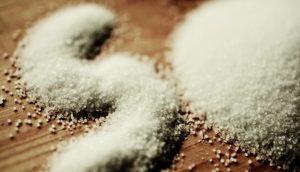Isn’t salt a bad thing for plants? As gardeners and growers, we are very aware of the damage caused by soil or excessively salty water. However, guess how long a plant could live without salt. The answer is not very long …
A plant can only absorb a nutrient when that nutrient is in the form of ionic salt. This is because there must be a membrane potential (positive versus negative) to provide energy and move the nutrient toward the cell cytoplasm.
Therefore, proper administration of nutrients is necessary for healthy plant growth. Knowing how these factors balance will greatly contribute to maintaining a healthy crop.
SALT AND NITROGEN
Let’s take a look to an organic nutrient; We will use nitrogen as an example. Plants need nitrogen to produce leaf growth (among other things), however, root systems can’t absorb nitrogen directly.
In chicken manure, approximately 80% of the nitrogen content is organic and must be mineralized or converted to ammonium or nitrate to be available for plant absorption. For some forms of nutrients, this process usually takes up to a year. Time, temperature and bacteria are required to perform the conversion.
This is the main reason why organic nutrient applications do not overfeed or burn a plant. The nutrient is simply not in a form that the roots absorb. It is after this conversion process that the nutrient becomes salt and is available for absorption.
BENEFITS OF ORGANIC NUTRIENTS
Most of the nutrients found in organic fertilizers are not yet in salt form, so the plant cannot absorb them. So, is there any benefit to this? Yes.
Let’s see the nitrogen again. There are different processes to convert nitrogen sources into ionic salt, and these coincide with the basic types of fertilizers. The first of these processes is hydrolysis, where nitrogen is converted by water.
The second is mineralization, where the microbial action of the soil converts the nitrogen source. The temperature completes the mineralization process. The processes or reactions that must occur in order for nitrogen to be available to the plant is quite complex.
During the mineralization of an organic nitrogen, the bacteria, in particular with the protozoa, are put to work consuming the nitrogen and converting it into nitrates, ammonium and other by-products. These nitrates are immediately available to the plant. This process takes time and increases the temperature and goes slowly, so the availability of nitrates is gradual and safe.
After nitrogen, phosphorus also requires the same type of reactions to become a salt and, therefore, available for plant absorption. Plants mainly absorb phosphorus as primary and secondary orthophosphate ions with negative charge.
Some prepared nutrients may have these already within the fertilizer compound, while organic forms require that mineralization processes occur first. This again makes the release of nutrients slower.

Granulated salt
LIVING SOIL
During the transformation of nitrogen, bacteria in the soil, such as nitrobacteria, along with a multitude of other bacteria and protozoa, feed continuously. As a result, microbes multiply and create a living soil.
The concentration of microbes in living soil can be amazing. A teaspoon of fertile soil can contain 100 million and even up to a billion bacteria. Up to more than 60 km of fungal filaments, or hyphae, can also be present in that small sample.
Living soil is the main basis for creating the vigor and health of plants to help growers obtain maximum yield on their crops. These microbes retain water in their cells that may be available to the plant later. Bacteria eat exudates from plants such as sugars, carbohydrates and applied organic nutrients.
The protozoa then excrete nutrients available to the plants. Beneficial fungi protect plant roots from pathogens and harmful microbes while forming a symbiotic relationship with the roots for greater nutrient absorption.
Mycorrhizae are an example of this. If you have ever used a soil impregnated with this beneficial fungus, you already know how much vigor, foliage, flower and additional fruit can be obtained from the plant.
In all cases, the mineralization process builds the life and health of the soil. The amount of benefits of living land is overwhelming, and this is the reason why many gardeners prefer to use organic nutrients.
USING UREA
When reading “nitrogen“, on the label of your fertilizer, you can see what percentage of the product is nitrate, ammonium nitrogen or urea soluble and insoluble in water.
Because many fertilizers use at least some, if not a large amount, of urea, it is useful to analyze this characteristic. Like organic forms of nitrogen, the mechanism of urea release is mineralization. Urea usually takes up to a month to be available to plants. However, there are several different types of urea and each has considerably different release times.
Cold water soluble urea becomes available to plants in a couple of weeks, while hot water soluble becomes available in 2 to 3 months, depending on soil temperature. Water-insoluble urea can take several years to release.
Because these nutrients can be available at such a variable rate, you can see why it is difficult to know if your crop is being fertilized in excess. Care must be taken and periodic soil tests can help you know if additional nutrients are needed. In addition, it is always better to read the label to know the assimilation characteristics of plant nutrients.

THE NEED OF MINERAL NUTRIENTS IN THE HYDROPONY
However, there are circumstances in which adding mineral nutrients ready for absorption to an organic nutrient base may have its advantages.
In cases where a plant shows signs of insufficient nutrition, sources of organic nutrients may be too slow to correct this deficiency in time to avoid a reduction in several desired crop characteristics. Adding the right amount of inorganic nutrients to the soil, or even a foliar application, may be the solution.
In many mineral fertilizers, the nutrients they contain can be absorbed immediately by the root system, or at least they will be available very quickly. For example, the form of nitrogen nitrate that is often provided in synthetic fertilizers is immediately available (which facilitates excessive fertilization of a plant).
While mineral nutrients do not sterilize the soil itself or feed the soil microbes, these microbes will still reproduce and do a good job as long as organic nutrients are present. It’s only when the producer depends solely on inorganic nutrients that the soil will gradually become sterile by starvation of the microbes.
Knowing the right amount and the right reason to add mineral nutrients is the key to success. In addition, during certain phases of growth, a stream of phosphorus or extra nitrogen can create several desired effects. Micronutrients, those that can add flavor, may also be necessary at a specific time during the growth and flowering cycles.
GET THE BEST OF BOTH WORLDS
In the end, remember that using organic forms of nutrients will build the soil while feeding your plants. This should be a priority for any grower. So try to keep an open mind about the use of mineral nutritive salts (fertilizers) in situations where they can benefit your crop.


